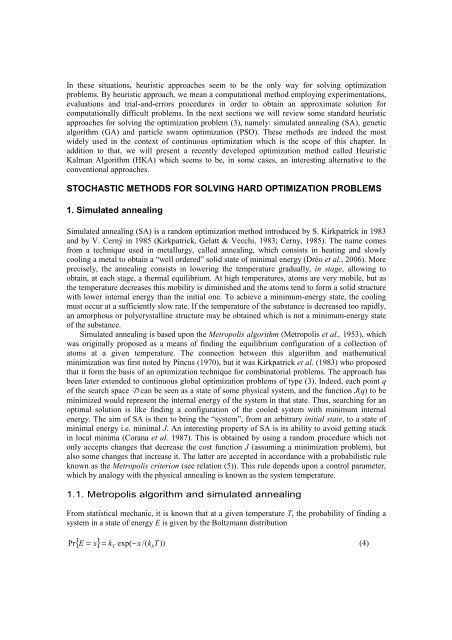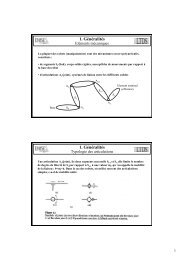q - Rosario Toscano - Free
q - Rosario Toscano - Free
q - Rosario Toscano - Free
You also want an ePaper? Increase the reach of your titles
YUMPU automatically turns print PDFs into web optimized ePapers that Google loves.
In these situations, heuristic approaches seem to be the only way for solving optimization<br />
problems. By heuristic approach, we mean a computational method employing experimentations,<br />
evaluations and trial-and-errors procedures in order to obtain an approximate solution for<br />
computationally difficult problems. In the next sections we will review some standard heuristic<br />
approaches for solving the optimization problem (3), namely: simulated annealing (SA), genetic<br />
algorithm (GA) and particle swarm optimization (PSO). These methods are indeed the most<br />
widely used in the context of continuous optimization which is the scope of this chapter. In<br />
addition to that, we will present a recently developed optimization method called Heuristic<br />
Kalman Algorithm (HKA) which seems to be, in some cases, an interesting alternative to the<br />
conventional approaches.<br />
STOCHASTIC METHODS FOR SOLVING HARD OPTIMIZATION PROBLEMS<br />
1. Simulated annealing<br />
Simulated annealing (SA) is a random optimization method introduced by S. Kirkpatrick in 1983<br />
and by V. Cerný in 1985 (Kirkpatrick, Gelatt & Vecchi, 1983; Cerny, 1985). The name comes<br />
from a technique used in metallurgy, called annealing, which consists in heating and slowly<br />
cooling a metal to obtain a “well ordered” solid state of minimal energy (Dréo et al., 2006). More<br />
precisely, the annealing consists in lowering the temperature gradually, in stage, allowing to<br />
obtain, at each stage, a thermal equilibrium. At high temperatures, atoms are very mobile, but as<br />
the temperature decreases this mobility is diminished and the atoms tend to form a solid structure<br />
with lower internal energy than the initial one. To achieve a minimum-energy state, the cooling<br />
must occur at a sufficiently slow rate. If the temperature of the substance is decreased too rapidly,<br />
an amorphous or polycrystalline structure may be obtained which is not a minimum-energy state<br />
of the substance.<br />
Simulated annealing is based upon the Metropolis algorithm (Metropolis et al., 1953), which<br />
was originally proposed as a means of finding the equilibrium configuration of a collection of<br />
atoms at a given temperature. The connection between this algorithm and mathematical<br />
minimization was first noted by Pincus (1970), but it was Kirkpatrick et al. (1983) who proposed<br />
that it form the basis of an optimization technique for combinatorial problems. The approach has<br />
been later extended to continuous global optimization problems of type (3). Indeed, each point q<br />
of the search space D can be seen as a state of some physical system, and the function J(q) to be<br />
minimized would represent the internal energy of the system in that state. Thus, searching for an<br />
optimal solution is like finding a configuration of the cooled system with minimum internal<br />
energy. The aim of SA is then to bring the “system”, from an arbitrary initial state, to a state of<br />
minimal energy i.e. minimal J. An interesting property of SA is its ability to avoid getting stuck<br />
in local minima (Corana et al. 1987). This is obtained by using a random procedure which not<br />
only accepts changes that decrease the cost function J (assuming a minimization problem), but<br />
also some changes that increase it. The latter are accepted in accordance with a probabilistic rule<br />
known as the Metropolis criterion (see relation (5)). This rule depends upon a control parameter,<br />
which by analogy with the physical annealing is known as the system temperature.<br />
1.1. Metropolis algorithm and simulated annealing<br />
From statistical mechanic, it is known that at a given temperature T, the probability of finding a<br />
system in a state of energy E is given by the Boltzmann distribution<br />
{ x}<br />
= k exp( −x<br />
/( k ))<br />
Pr = T<br />
(4)<br />
E T<br />
b



